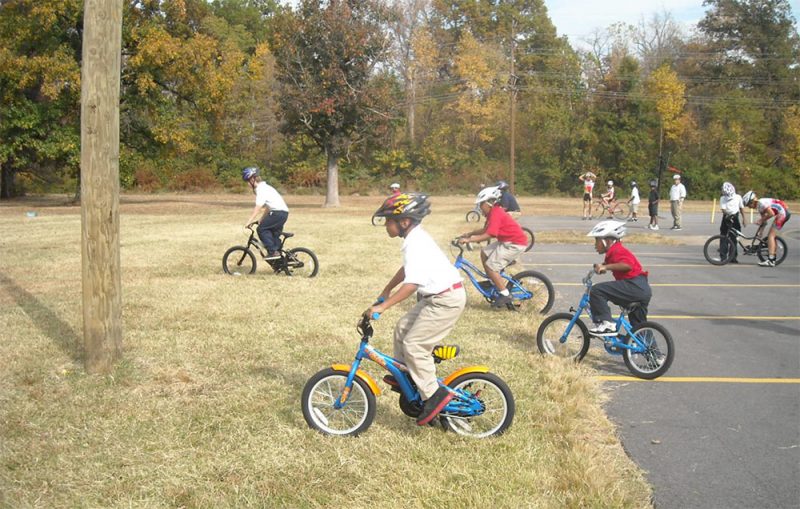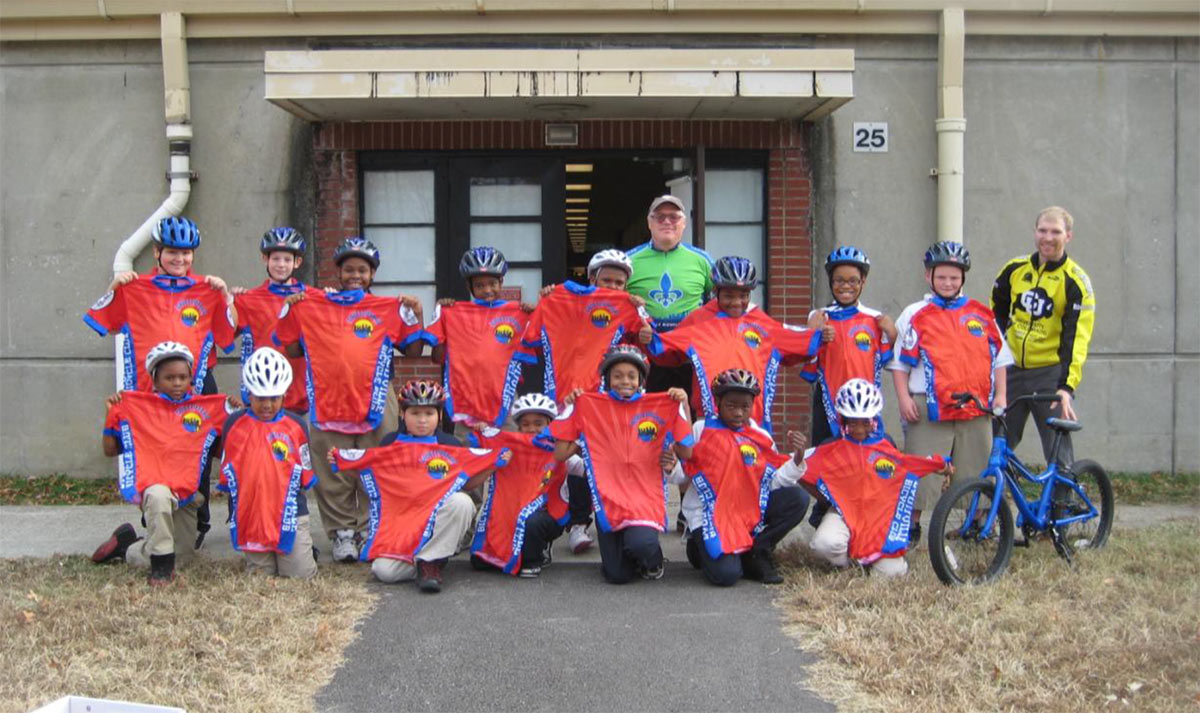Bike Louisville, the city agency that oversees both bikes and pedestrians, has received thousands in grant money from the Paula Nye Memorial Bicyclist & Pedestrian Education Grant, which is supplied with funds from those “Share the Road” bike license plates on cars. Rolf Eisinger, bike and pedestrian coordinator at Bike Louisville, recently accepted the award of $29,400 from the Kentucky Bicycle & Bikeway Commission (KBBC).
Of those funds, Bike Louisville plans to spend $11,900 on a program to “educate youths to bicycle and walk defensively.” And part of that means a crackdown on jaywalking. Or at least a fake one. According to the KBBC, “the funding will allow several LMPD officers to bicycle in targeted areas around each of the nine community centers and hand out educational “citations” to youth who are not following the rules of the road.” According to Bike Louisville’s grant application, “The classes will teach our youth to walk and bicycle defensively, to anticipate dangerous situations, and to react appropriately.”
And that has been sparking controversy in online forums.
Louisville’s streets are deadly, built with the sole purpose of moving cars rapidly, and the city ranks above the national average for pedestrian fatalities—it’s not easy for anyone outside of a car to get around. We’re not going to educate our pedestrians out of our street safety problem. And even the most defensive walker is still no match for a distracted driver.
Eisinger defended the program on a heated thread of the Bicycling for Louisville Facebook page, noting that he believes education is always important. “Not sure if there isn’t a time that providing education to our youth about life making decisions is not warranted,” he said. “A lot of our streets aren’t as safe as they need be and education is just one tool that can be used.”
And to be fair, despite a poorly worded Facebook announcement from the KBBC, it does sound like these fake citations won’t be on Louisville streets at large, but only at nine community centers hosting summer programs for kids. But the message it sends is still problematic.
While educating children in proper street safety is certainly important, the underlying message that we should raise our children to “walk defensively” on Louisville streets misses the mark. On the surface, it appears to condone Louisville’s unsafe streets and place responsibility for dealing with it on the shoulders of bikers and pedestrians. Additionally, on our city’s dangerous streets, sometimes the safest place to cross the street is actually in the middle of a block, not at a crosswalk where multiple chaotic turning motions of motorists can end up being more dangerous—which could be termed jaywalking. What’s worse, this approach could end up teaching some Louisville pedestrians that our streets are unsafe and they’re better off driving in a car to avoid the risk. And as we have already explored in depth, jaywalking to begin with was originally a campaign begun by car manufacturers to stigmatize walking and get people off the street to make them easier to drive cars on.
While one quick reaction to hearing about a program like this is to suggest flipping the scenario and ticketing motorists for dangerous behavior instead, it’s important to remember that Paula Nye Memorial Grant is limited in what it funds. The grant can only be used for certain educational endeavors:
- To educate and inform in matters pertaining to bicycle and pedestrian safety through the development of curriculum, training aids, and/or educational programs or projects directly related to bicycle and pedestrian safety.
- To educate and inform about the health, recreational, economic,
social, cultural, and other benefits arising from bicycling and walking. - To promote other bicycling and pedestrian related non-profit, educational and purposes as deemed appropriate by the KBBC.
In future funding cycles (no pun intended), it would be great to see the city use such grant money for bike and pedestrian encouragement. In New York, for example, the city, in partnership with nonprofits, regularly sets up bicycling booths on highly trafficked areas where they hand out bike bells and lights, breakfast energy bars and drinks to morning commuters, and generally encourage cyclists to make them feel like they belong on the street. And while not everyone on a bike will stop and grab an energy bar, I can speak from experience that seeing people waving and shouting good morning simply because you’re on a bike certainly brightens up your normal commute.

The city believes the effort in question, called the Summer Bike/Walk Sense and Bike Sense Cops for Kids Program, could reach up to 500 youths this summer. Bike Louisville said in its application that the Bike Sense program funds would pay for 500 youth bicycle helmets, 10 youth bicycles, equipment repair, coloring books, class time, and police overtime.
Bike Louisville devised the fake citation component to test whether youth involved in the program are retaining the information taught in the defensive walking classes. “Based on last year’s results it is estimated that sixty youth or 6 youth per community center will be reached while patrolling,” Bike Louisville wrote in its grant application.
Bike Louisville’s remaining Paula Nye funds will be used for the Travel with Care Campaign ($15,000) that “is aimed at humanizing people on bikes and encouraging better behavior among drivers and bike riders,” and the Earn a Bike Education program ($2,500) to fund a series of “bicycle safety and bicycling for transportation” classes required as part of the University of Louisville’s Earn-A-Bike program where students give up their parking permits in exchange for a $400 bike voucher and taking the aforementioned classes.
The Paula Nye Memorial Grant is named after Paula Nye, who served as Kentucky’s Bicycle & Pedestrian Coordinator from 2000–2005.



Rolf has the right attitude here: ““Not sure if there isn’t a time that providing education to our youth about life making decisions is not warranted,” he said. “A lot of our streets aren’t as safe as they need be and education is just one tool that can be used.””
Although that triple-negative in the first sentence might have been expressed a little more smoothly. How about, “Providing education to our youth about life-making decisions is always warranted”?
This whole paragraph is a mess:
“While educating children in proper street safety is certainly important, the underlying message that we should raise our children to “walk defensively” on Louisville streets misses the mark. On the surface, it appears to condone Louisville’s unsafe streets and place responsibility for dealing with it on the shoulders of bikers and pedestrians. Additionally, on our city’s dangerous streets, sometimes the safest place to cross the street is actually in the middle of a block, not at a crosswalk where multiple chaotic turning motions of motorists can end up being more dangerous—which could be termed jaywalking. What’s worse, this approach could end up teaching some Louisville pedestrians that our streets are unsafe and they’re better off driving in a car to avoid the risk. And as we have already explored in depth, jaywalking to begin with was originally a campaign begun by car manufacturers to stigmatize walking and get people off the street to make them easier to drive cars on.”
“it appears to condone Louisville’s unsafe streets and place responsibility on [pedestrians/cyclists]” – If I tell you to mind your wallet as you walk through an area where pick-pocketing is frequent, have I condoned pick-pocketing, or blamed you as responsible for pick-pocketing?
“this approach could end up teaching some Louisville pedestrians that our streets are unsafe” – This is an objective truth, and one that is highlighted frequently on this very website. Why wouldn’t we want to make sure that kids know that Louisville streets are often unsafe? Obviously it should be a shared goal to make them more safe, but fostering ignorance about the real risks in the meantime isn’t a good idea.
“and they’re better off driving in a car to avoid the risk” – it depends on the route and the experience level of the pedestrian/cyclist. It would be great if we lived in a city where any pedestrian or cyclist could take any route safely, and we should work toward that goal. But that city doesn’t exist right now, and right now there are real safety hazards for real people that shouldn’t be waved aside as incompatible with our idealized goals.